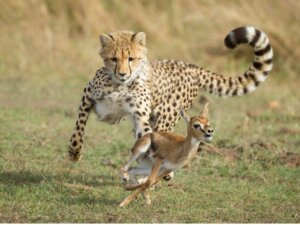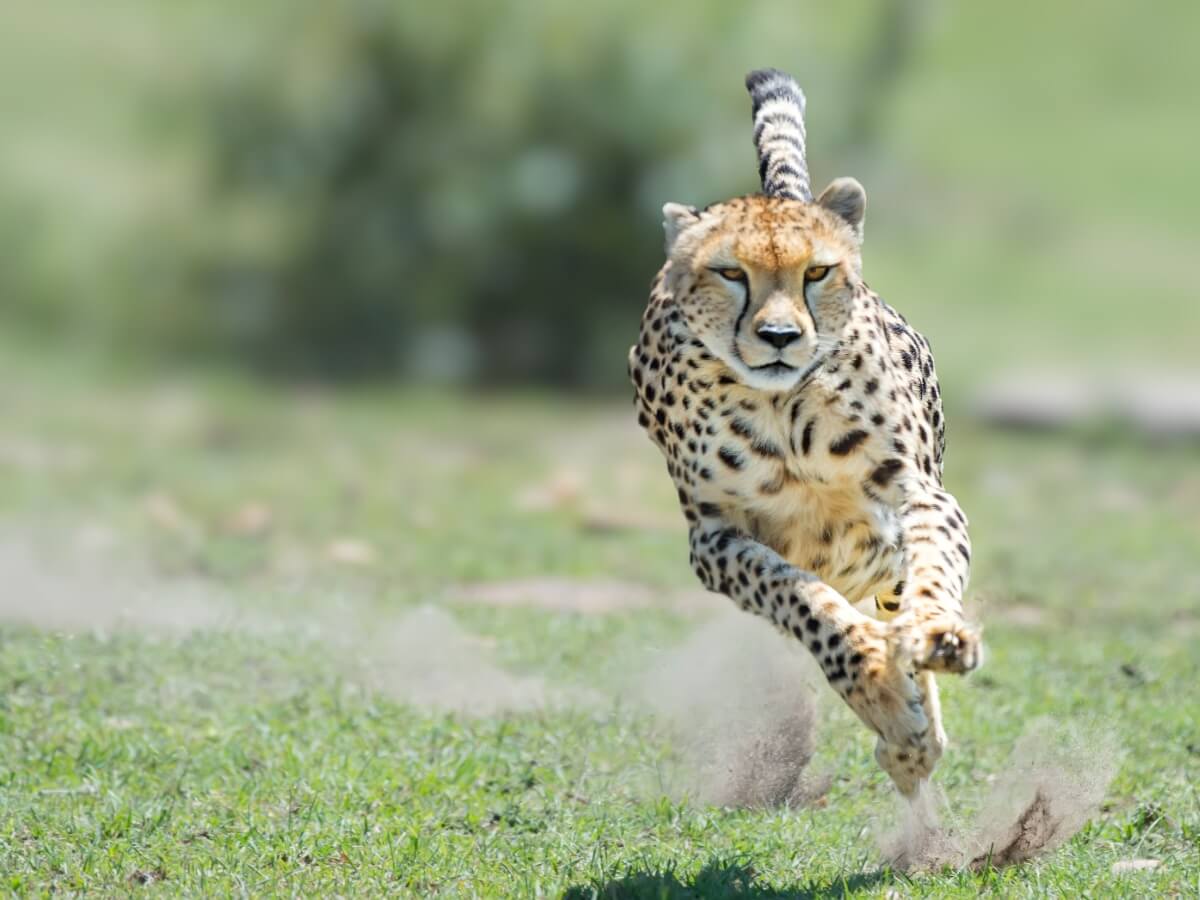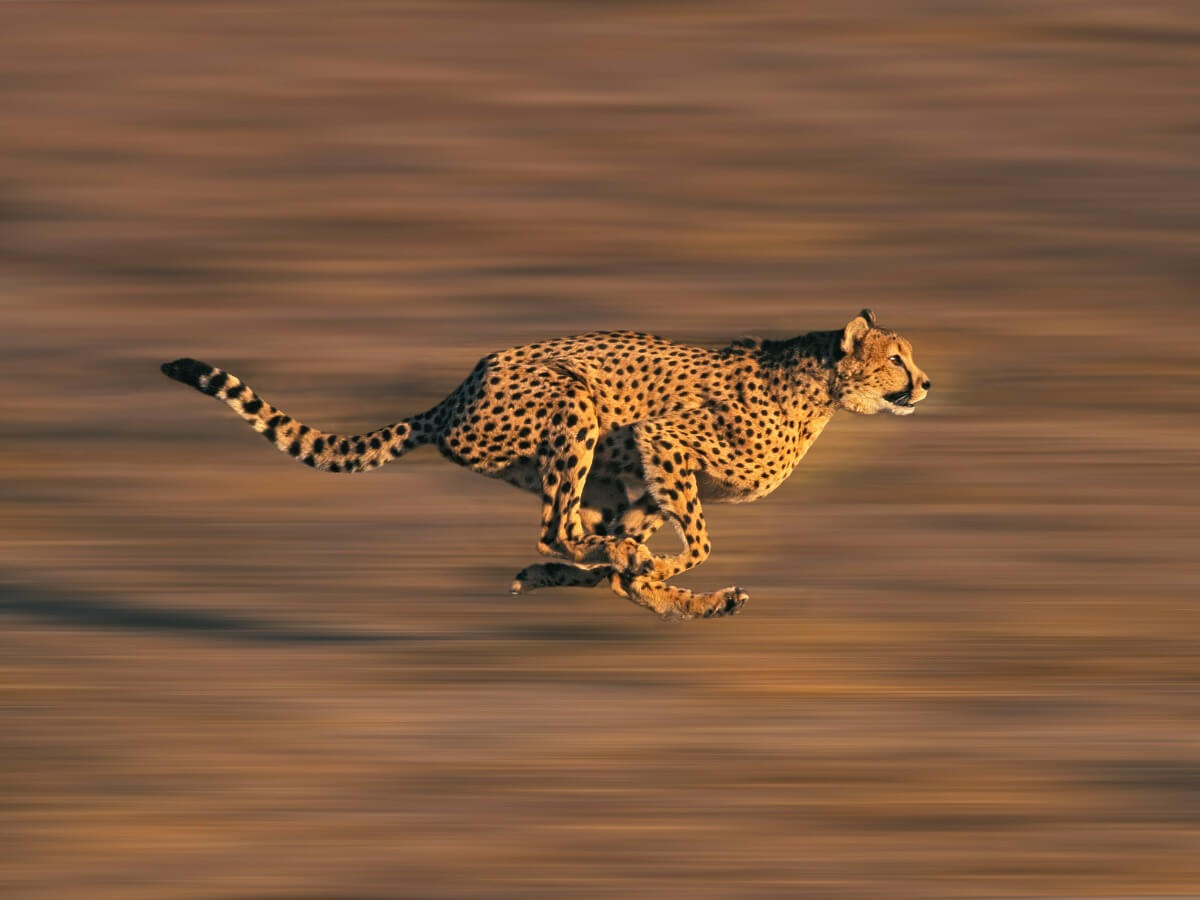All About Cheetah Behavior

Although they’re famous for their explosive runs, cheetah behavior is no less interesting than the rest of its characteristics. In addition, this mammal is quite different from other big cats that it shares the savannah with.
However, the study of cheetah behavior and its biological makeup is becoming increasingly necessary, as it’s a species doomed to extinction and reproduction in captivity isn’t bearing fruit. Hunting to protect livestock and to sell are the main threats to this cat. Here we’ll you everything about it.
Cheetah characteristics
The cheetah (Acinonyx jubatus) is a placental mammal that belongs to the Felidae family. It’s the only known species of the genus Acinonyx and the fastest land animal in the world. It reaches a whopping 114 kilometers/hour in just 10 seconds.
It’s a medium-sized feline that measures 150-170 centimeters (5 – 5.5 feet) and it can weigh between 35 and 60 kilos (75 to 130 pounds). Males are slightly larger than females. In addition, experts state that there are four distinct subspecies of this great animal.
Their diet is strictly carnivorous and is made up of medium-sized animals, such as gazelles or impalas. Although it has no predators, its main competitors are hyenas, who take advantage of its fatigue after hunting to steal its prey.
Most of the wild cheetah population – barely 12,000 specimens – is distributed in eastern and south-western Africa, in the Serengeti National Park. The main habitat of the cheetah is the savannah, although it can also be found in other open places, such as large grasslands.
Their adaptations to hunting are really interesting and have been studied for application to modern technology. Here are some of the qualities of this true killing machine:
- Oxygen optimization: A cheetah’s lungs are larger compared to other species, as are their nostrils. As if that weren’t enough, their muscles also take better advantage of the oxygen that reaches them, allowing them to maintain their explosive sprint for longer.
- Their nails aren’t retractable: This allows them a better grip on the ground while running and better traction, preventing them from slipping at high speeds.
- They’re able to keep their heads still as they run: They do this thanks to their inner ear, a relatively modern adaptation that expands their vestibular system to maintain balance without losing sight of the prey.

Cheetah character
It’s not as aggressive as the other big cats. It’s shy about interaction with humans and wanders away from their settlements; it’ll only attack livestock in cases of extreme malnutrition. Nor does it risk stealing the prey of other animals.
Communication in cheetah behavior
A good part of their communication is based on smell. With it, cheetahs are able to identify themselves individually through urine markings. The pheromones released by the female during oestrus is also a signal to the males in the area to mate — thus preventing them from attacking her when she enters their territory.
The cheetah isn’t capable of roaring, but it does have a repertoire of vocalizations based on grunts and purrs. The objective of the vocalizations is usually to warn of an attack or to call each other from a distance.
Females with offspring have a unique call for the young when they lose sight of them or wander away from the den. Curiously, this call resembles the song of a bird, a detail that experts believe they use to avoid attracting the attention of other predators in the area.
When members of a group break up, they use vocal calls to meet. However, it’s rare for them to move away from each other, as they’re usually in close physical contact.
Cheetah behavior
The cheetah’s habits are diurnal and solitary. Their activity peaks are at dawn, dusk and the central hours of the day. This is when other predators rest and, therefore, don’t compete with them.
Males tend to be more territorial than females, marking the area they defend with urine, feces, and markings on trees or dirt with their claws. They only leave their territory to look for females in their reproductive period.
Social behavior
The females are purely solitary, unlike the males. Among the males, there can be several situations:
- Family groups: These are usually young, related males, who have just separated from their mother and they work together to hunt.
- Mixed groups: Sometimes solitary males join other groups already formed without being related to them. They’re usually very young or old cheetahs.
- Nomadic males: These cats don’t spend more than a couple of days in each territory and don’t usually join any group of males. It’s common to see elderly individuals with this type of behavior, and also adults who aren’t accepted in any group.
When skirmishes between males occur, usually the largest group wins. On the other hand, accepting a new cheetah into a family coalition usually involves a process fraught with aggression and tension, but once it’s included in the group, the union is usually for life.
Reproductive behavior
The females are polygamous and look for several males in their area. Their reproductive cycle is polyestric – more than one sexual cycle per heat – and they’re receptive for 12 days in each one of them. While they respond to the calls of the males entering their territory, they try to protect their area.
Courtship rituals haven’t been reported in cheetah behavior. Normally, it’s the male who initiates the approach and the female awaits him in a copula pose.
On the other hand, parental care is performed exclusively by females. After the birth of the young, the mother keeps them in a sheltered place for a period of 8 weeks, although they’re usually weaned at 6 weeks.
Juveniles remain with their mothers until they reach 15 to 17 months of age. During this period, they accompany their mother to learn hunting techniques. In fact, the adult female hunts prey and brings them to her young to stimulate their hunting instinct.
Cheetah behavior in captivity
In cases where experts have studied cheetah behavior in captivity, they have observed a fairly high occurrence of conduct disorders. Among them, meaningless repetitive movements and self-harm are the most common.
On the other hand, the solitary behavior of this species seems to be diluted somewhat in captivity. Females – the most asocial – have been kept in the same facility without deadly conflicts. Males have been able to form larger coalitions.
Seclusion also affects reproduction, making it almost impossible. This is a problem for captive breeding programs, as lack of space appears to override the female reproductive instinct.
Hunting and feeding techniques
The cheetah’s hunting behavior is both effective and deliberate. In fact, its effectiveness in killing prey is 60%, compared to 25% for other big cat species.
The cheetah carefully studies the terrain before launching itself towards its prey. It does so because the explosiveness of its run is detrimental to its strength. If it can’t reach its victim, it’ll need to rest for about 20 minutes before it can stand up, leaving it in a vulnerable position.
In addition, the cheetah chooses the hunting tactic based on the terrain and the situation, always preferring places that allow it to get as close as possible before launching the attack. Its sudden appearance will cause the herds to separate, allowing it to jump on the closest one.
If, on the other hand, the terrain is uneven and doesn’t allow it to hide, the cat will wait for one of them to separate from the group to ambush it. It can also carry out a slower distance run that makes the group of prey move together, giving it time to select a particular one that’s easier to catch.

These animals are wonders of biological engineering that never cease to amaze us. Unfortunately, they’re always vulnerable to extinction. Their population decreases every year and there’s no choice but to protect them in their natural environment. However, there’s still hope for them, as more and more people are joining in the fight for their conservation.
Although they’re famous for their explosive runs, cheetah behavior is no less interesting than the rest of its characteristics. In addition, this mammal is quite different from other big cats that it shares the savannah with.
However, the study of cheetah behavior and its biological makeup is becoming increasingly necessary, as it’s a species doomed to extinction and reproduction in captivity isn’t bearing fruit. Hunting to protect livestock and to sell are the main threats to this cat. Here we’ll you everything about it.
Cheetah characteristics
The cheetah (Acinonyx jubatus) is a placental mammal that belongs to the Felidae family. It’s the only known species of the genus Acinonyx and the fastest land animal in the world. It reaches a whopping 114 kilometers/hour in just 10 seconds.
It’s a medium-sized feline that measures 150-170 centimeters (5 – 5.5 feet) and it can weigh between 35 and 60 kilos (75 to 130 pounds). Males are slightly larger than females. In addition, experts state that there are four distinct subspecies of this great animal.
Their diet is strictly carnivorous and is made up of medium-sized animals, such as gazelles or impalas. Although it has no predators, its main competitors are hyenas, who take advantage of its fatigue after hunting to steal its prey.
Most of the wild cheetah population – barely 12,000 specimens – is distributed in eastern and south-western Africa, in the Serengeti National Park. The main habitat of the cheetah is the savannah, although it can also be found in other open places, such as large grasslands.
Their adaptations to hunting are really interesting and have been studied for application to modern technology. Here are some of the qualities of this true killing machine:
- Oxygen optimization: A cheetah’s lungs are larger compared to other species, as are their nostrils. As if that weren’t enough, their muscles also take better advantage of the oxygen that reaches them, allowing them to maintain their explosive sprint for longer.
- Their nails aren’t retractable: This allows them a better grip on the ground while running and better traction, preventing them from slipping at high speeds.
- They’re able to keep their heads still as they run: They do this thanks to their inner ear, a relatively modern adaptation that expands their vestibular system to maintain balance without losing sight of the prey.

Cheetah character
It’s not as aggressive as the other big cats. It’s shy about interaction with humans and wanders away from their settlements; it’ll only attack livestock in cases of extreme malnutrition. Nor does it risk stealing the prey of other animals.
Communication in cheetah behavior
A good part of their communication is based on smell. With it, cheetahs are able to identify themselves individually through urine markings. The pheromones released by the female during oestrus is also a signal to the males in the area to mate — thus preventing them from attacking her when she enters their territory.
The cheetah isn’t capable of roaring, but it does have a repertoire of vocalizations based on grunts and purrs. The objective of the vocalizations is usually to warn of an attack or to call each other from a distance.
Females with offspring have a unique call for the young when they lose sight of them or wander away from the den. Curiously, this call resembles the song of a bird, a detail that experts believe they use to avoid attracting the attention of other predators in the area.
When members of a group break up, they use vocal calls to meet. However, it’s rare for them to move away from each other, as they’re usually in close physical contact.
Cheetah behavior
The cheetah’s habits are diurnal and solitary. Their activity peaks are at dawn, dusk and the central hours of the day. This is when other predators rest and, therefore, don’t compete with them.
Males tend to be more territorial than females, marking the area they defend with urine, feces, and markings on trees or dirt with their claws. They only leave their territory to look for females in their reproductive period.
Social behavior
The females are purely solitary, unlike the males. Among the males, there can be several situations:
- Family groups: These are usually young, related males, who have just separated from their mother and they work together to hunt.
- Mixed groups: Sometimes solitary males join other groups already formed without being related to them. They’re usually very young or old cheetahs.
- Nomadic males: These cats don’t spend more than a couple of days in each territory and don’t usually join any group of males. It’s common to see elderly individuals with this type of behavior, and also adults who aren’t accepted in any group.
When skirmishes between males occur, usually the largest group wins. On the other hand, accepting a new cheetah into a family coalition usually involves a process fraught with aggression and tension, but once it’s included in the group, the union is usually for life.
Reproductive behavior
The females are polygamous and look for several males in their area. Their reproductive cycle is polyestric – more than one sexual cycle per heat – and they’re receptive for 12 days in each one of them. While they respond to the calls of the males entering their territory, they try to protect their area.
Courtship rituals haven’t been reported in cheetah behavior. Normally, it’s the male who initiates the approach and the female awaits him in a copula pose.
On the other hand, parental care is performed exclusively by females. After the birth of the young, the mother keeps them in a sheltered place for a period of 8 weeks, although they’re usually weaned at 6 weeks.
Juveniles remain with their mothers until they reach 15 to 17 months of age. During this period, they accompany their mother to learn hunting techniques. In fact, the adult female hunts prey and brings them to her young to stimulate their hunting instinct.
Cheetah behavior in captivity
In cases where experts have studied cheetah behavior in captivity, they have observed a fairly high occurrence of conduct disorders. Among them, meaningless repetitive movements and self-harm are the most common.
On the other hand, the solitary behavior of this species seems to be diluted somewhat in captivity. Females – the most asocial – have been kept in the same facility without deadly conflicts. Males have been able to form larger coalitions.
Seclusion also affects reproduction, making it almost impossible. This is a problem for captive breeding programs, as lack of space appears to override the female reproductive instinct.
Hunting and feeding techniques
The cheetah’s hunting behavior is both effective and deliberate. In fact, its effectiveness in killing prey is 60%, compared to 25% for other big cat species.
The cheetah carefully studies the terrain before launching itself towards its prey. It does so because the explosiveness of its run is detrimental to its strength. If it can’t reach its victim, it’ll need to rest for about 20 minutes before it can stand up, leaving it in a vulnerable position.
In addition, the cheetah chooses the hunting tactic based on the terrain and the situation, always preferring places that allow it to get as close as possible before launching the attack. Its sudden appearance will cause the herds to separate, allowing it to jump on the closest one.
If, on the other hand, the terrain is uneven and doesn’t allow it to hide, the cat will wait for one of them to separate from the group to ambush it. It can also carry out a slower distance run that makes the group of prey move together, giving it time to select a particular one that’s easier to catch.

These animals are wonders of biological engineering that never cease to amaze us. Unfortunately, they’re always vulnerable to extinction. Their population decreases every year and there’s no choice but to protect them in their natural environment. However, there’s still hope for them, as more and more people are joining in the fight for their conservation.
All cited sources were thoroughly reviewed by our team to ensure their quality, reliability, currency, and validity. The bibliography of this article was considered reliable and of academic or scientific accuracy.
- Grohé, C., Lee, B. & Flynn, J.J. Recent inner ear specialization for high-speed hunting in cheetahs. Sci Rep 8, 2301 (2018). https://doi.org/10.1038/s41598-018-20198-3
- A. M. Wilson, J. C. Lowe, K. Roskilly, P. E. Hudson, K. A. Golabek y J. W. McNutt. “Locomotion dynamics of hunting in wild cheetahs” Nature, Junio 2013, doi:10.1038/nature1229
- Tang, Y. (2020, 1 mayo). Leveraging elastic instabilities for amplified performance: Spine-inspired high-speed and high-force soft robots. Science Advances. https://advances.sciencemag.org/content/6/19/eaaz6912?utm_source=TrendMD&utm_medium=cpc&utm_campaign=TrendMD_1
- Durant, S., Mitchell, N., Ipavec, A. & Groom, R. 2015. Acinonyx jubatus. The IUCN Red List of Threatened Species 2015: e.T219A50649567. https://dx.doi.org/10.2305/IUCN.UK.2015-4.RLTS.T219A50649567.en. Downloaded on 22 June 2021.
- Bradford-Wright, R. R., & Hons, B. A. (2013). Social and reproductive behaviours in the cheetah (Acinonyx jubatus) in a captive population. Flinders University of South Australia, School of Biological Sciences.
- Chadwick, C. (2014). Social behaviour and personality assessment as a tool for improving the management of cheetahs (Acinonyx jubatus) in captivity.
- Acinonyx jubatus (cheetah). (2021). Animal Diversity Web. https://animaldiversity.org/accounts/Acinonyx_jubatus/#communication
This text is provided for informational purposes only and does not replace consultation with a professional. If in doubt, consult your specialist.








